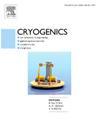Thermomechanics of a Kevlar cord suspension for cryogenic spacecraft instruments
IF 2.1
3区 工程技术
Q3 PHYSICS, APPLIED
引用次数: 0
Abstract
Kevlar cord suspensions in cryogenic instruments are used to suspend cold temperature stages to warmer temperature stages. The heating of Kevlar in these suspensions and the effect on its mechanical properties like stiffness and failure load are scarcely described in the literature. For instruments such as the X-IFU instrument of the Athena mission it is necessary to characterize the mechanical and thermal properties of these suspensions when subjected to sinusoidal and random vibrations transmitted to the instrument by the launch vehicle.
A compact isostatic Kevlar cord suspension was designed, built and tested on an electrodynamic shaker. Significant heating, presumably caused by friction, was demonstrated with an infrared camera. A dynamic model of the suspension was validated for small loads. At large loads the stiffness of the cords decreased with temperature. A thermal model was experimentally validated, thermal properties of the system were determined. Failure occurred at the highest load levels, when the maximum recommended temperature for Kevlar in air was reached.
低温航天器仪器用凯夫拉绳悬吊的热力学
低温仪器中的凯夫拉绳悬浮物用于将低温阶段悬浮到温度较高的阶段。在这些悬浮液中凯夫拉的加热及其对其机械性能的影响,如刚度和失效载荷,在文献中几乎没有描述。对于仪器,如雅典娜任务的X-IFU仪器,有必要对这些悬架在受到由运载火箭传递给仪器的正弦和随机振动时的机械和热性能进行表征。设计了一种紧凑的等静力凯夫拉绳悬架,并在电动振动筛上进行了测试。可能是摩擦引起的明显发热用红外摄像机进行了演示。在小载荷下,对悬架的动力学模型进行了验证。在大载荷下,绳索的刚度随着温度的升高而降低。实验验证了热模型,确定了系统的热性能。故障发生在最高负载水平,当空气中凯夫拉尔的最高推荐温度达到。
本文章由计算机程序翻译,如有差异,请以英文原文为准。
求助全文
约1分钟内获得全文
求助全文
来源期刊

Cryogenics
物理-热力学
CiteScore
3.80
自引率
9.50%
发文量
0
审稿时长
2.1 months
期刊介绍:
Cryogenics is the world''s leading journal focusing on all aspects of cryoengineering and cryogenics. Papers published in Cryogenics cover a wide variety of subjects in low temperature engineering and research. Among the areas covered are:
- Applications of superconductivity: magnets, electronics, devices
- Superconductors and their properties
- Properties of materials: metals, alloys, composites, polymers, insulations
- New applications of cryogenic technology to processes, devices, machinery
- Refrigeration and liquefaction technology
- Thermodynamics
- Fluid properties and fluid mechanics
- Heat transfer
- Thermometry and measurement science
- Cryogenics in medicine
- Cryoelectronics
 求助内容:
求助内容: 应助结果提醒方式:
应助结果提醒方式:


